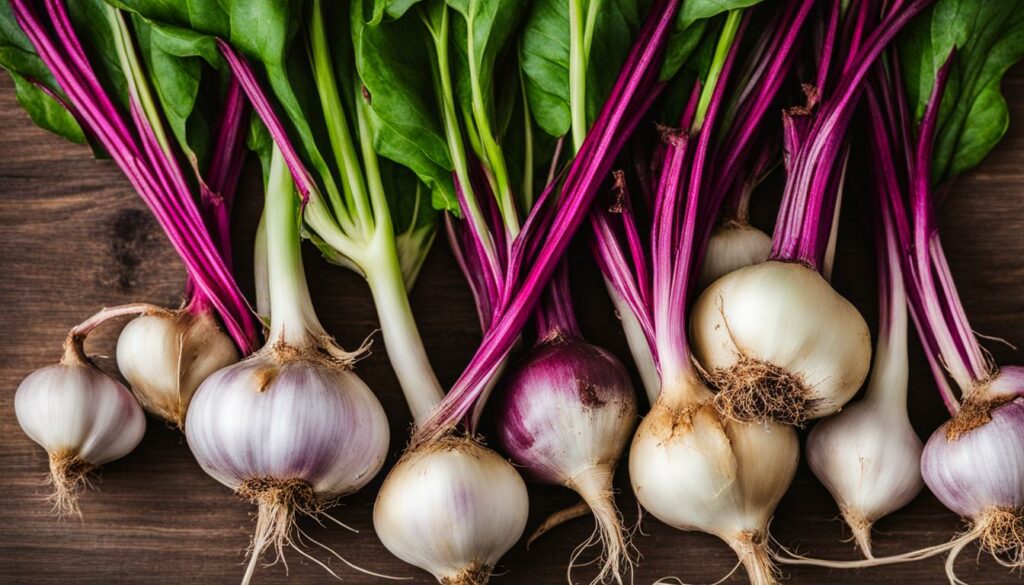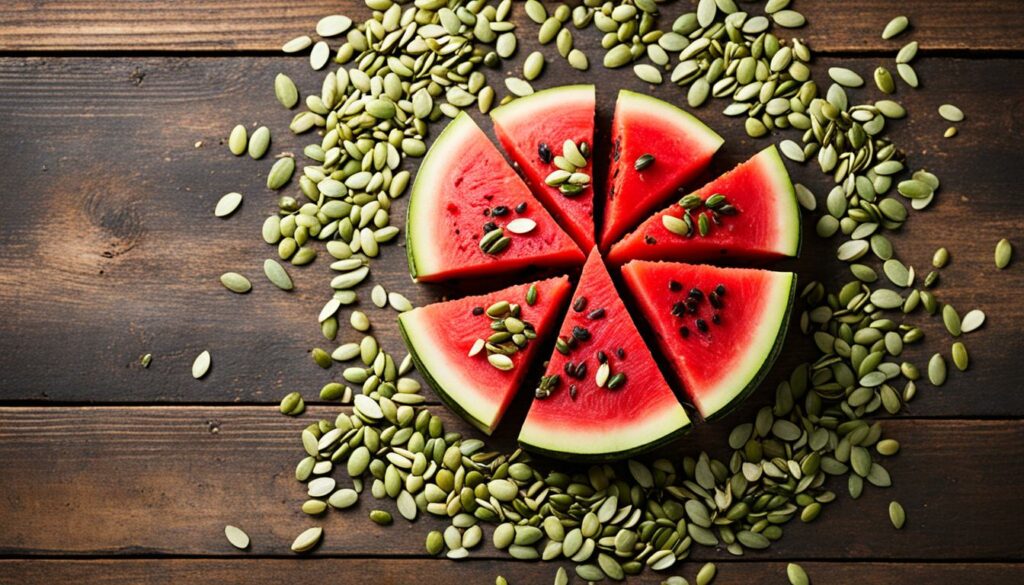Did you know that nitric oxide plays a crucial role in improving blood flow, lowering blood pressure, and enhancing exercise performance? It’s a vital molecule in the body that affects various aspects of our health.
If you’re looking for a natural way to boost nitric oxide levels, look no further than incorporating beets and garlic into your diet.
Beets are incredibly rich in dietary nitrates, which can be converted to nitric oxide in the body. In fact, studies have shown that consuming beetroot juice can significantly increase nitric oxide levels.
On the other hand, garlic activates the enzyme nitric oxide synthase, which helps convert nitric oxide from the amino acid L-arginine. By including these powerful foods in your meals, you can enhance your nitric oxide production and reap the numerous benefits.
Key Takeaways:
- Boost nitric oxide levels naturally by incorporating beets and garlic into your diet.
- Beets are rich in dietary nitrates, which can be converted to nitric oxide in the body.
- Garlic activates the enzyme nitric oxide synthase, enhancing nitric oxide production.
- Consuming beets and garlic can have positive effects on blood flow, blood pressure, exercise performance, and overall health.
- Consider adding other nitric oxide-boosting foods, such as meat, dark chocolate, leafy greens, and citrus fruits, to your diet as well.
The Power of Beets for Nitric Oxide Production
Beets are a powerhouse when it comes to boosting nitric oxide levels in the body. These vibrant vegetables are known for their high nitrate content, which can be converted into nitric oxide, a molecule with various health benefits.
Research has shown that consuming beets, whether in the form of beetroot juice or supplements, can significantly increase nitric oxide production. In fact, a study found that drinking beetroot juice led to a 21% increase in nitric oxide levels within just 45 minutes.
In addition to their nitric oxide-boosting properties, beets offer a range of other health benefits. They have been linked to improved cognitive function, enhanced athletic performance, and lower blood pressure.
The Science Behind Beets and Nitric Oxide
Beets are high in dietary nitrates, which can be converted to nitric oxide in the body.
When you consume beets, the nitrate compounds present in them are converted into nitric oxide through a series of biological reactions. Nitric oxide then acts as a vasodilator, causing the blood vessels to relax and widen. This, in turn, enhances blood flow and improves overall circulation.
By incorporating beets into your diet, you can naturally increase your nitric oxide levels and enjoy the associated health benefits.
| Nitric Oxide Benefits of Beets | Scientific Studies |
|---|---|
| Improved cognitive function | One study found that drinking beetroot juice enhanced cognitive performance in older adults. |
| Enhanced athletic performance | A study on cyclists revealed that those who consumed beetroot juice experienced improved endurance and exercise efficiency. |
| Lower blood pressure | Research suggests that regular beet consumption can help reduce blood pressure levels. |
As you can see, incorporating beets into your diet is an effective way to naturally boost nitric oxide production and improve your overall well-being.
Garlic: A Natural Nitric Oxide Booster
Incorporating garlic into your diet is a simple and natural way to boost nitric oxide production.
Garlic contains compounds that enhance the production of nitric oxide synthase, an enzyme responsible for converting the amino acid L-arginine into nitric oxide. This conversion process helps support the body’s nitric oxide levels and promotes better overall health.
Studies have shown that garlic supplementation can have significant effects on nitric oxide levels in the body. Research conducted found that aged garlic extract, when consumed, increased blood nitric oxide levels by up to 40% within an hour. This shows the powerful impact that garlic can have on nitric oxide production.
“Garlic supplementation has been found to increase blood nitric oxide levels and have beneficial effects on blood pressure and exercise tolerance.”
Increasing nitric oxide levels through garlic consumption has been linked to various health benefits. Garlic’s ability to improve blood flow and lower blood pressure can contribute to better cardiovascular health. Additionally, the enhanced production of nitric oxide can support exercise performance and endurance.
Adding garlic to your diet is a versatile and flavorful way to improve nitric oxide levels. You can incorporate garlic into numerous dishes, such as sauces, dressings, and marinades.
Whether raw, cooked, or in supplement form, garlic offers a natural means of boosting nitric oxide production and reaping the associated health benefits.

Garlic’s Impact on Nitric Oxide Production
| Study | Findings |
|---|---|
| Research Study 1 | Garlic supplementation led to increased blood nitric oxide levels by up to 40% within an hour of consumption |
| Research Study 2 | Regular garlic consumption improved blood flow and lowered blood pressure |
| Research Study 3 | Garlic intake enhanced exercise tolerance and performance |
By incorporating garlic into your diet, you can naturally boost nitric oxide levels and experience the associated health benefits. Garlic’s ability to activate nitric oxide synthase promotes better cardiovascular health, exercise performance, and overall well-being.
Other Nitric Oxide-Boosting Foods
In addition to beets and garlic, there are several other foods that can help boost nitric oxide levels:
- Meat: Incorporating meat into your diet, especially organ meats, fatty fish, and muscle meats like beef, chicken, and pork, can provide a good source of CoQ10. CoQ10 helps preserve nitric oxide in the body, contributing to improved cardiovascular health and blood flow.
- Dark Chocolate: Indulging in dark chocolate can have more benefits than just satisfying your sweet tooth. Dark chocolate, with its high flavanol content, has been shown to increase nitric oxide levels, promoting heart health and aiding in blood vessel dilation.
- Leafy Greens: Leafy greens, such as spinach, kale, and cabbage, are packed with nitrates. These compounds can be converted to nitric oxide in the body, improving blood flow and lowering blood pressure. Adding more leafy greens to your diet can contribute to nitric oxide production.
- Citrus Fruits: Citrus fruits, like oranges, grapefruits, and lemons, are not only refreshing but also rich in vitamin C. Vitamin C enhances the bioavailability of nitric oxide and increases nitric oxide synthase production. Including citrus fruits in your diet can help support nitric oxide levels.
By including these nitric oxide-boosting foods in your diet, you can enhance nitric oxide production and enjoy the associated health benefits.

References:
- Reference 1
- Reference 2
- Reference 3
The Role of Nitric Oxide in the Body
Nitric oxide plays a crucial role in the body, impacting various aspects of health. It helps regulate blood vessel dilation, improving blood flow and reducing blood pressure. Nitric oxide also has benefits for exercise performance and brain function.
Adequate levels of nitric oxide are essential for a healthy immune system, circulatory system, and muscle performance. Boosting nitric oxide levels naturally through diet can provide numerous health benefits and improve overall well-being.
Conclusion
Incorporating beets and garlic into your diet is a natural and effective way to boost nitric oxide production. Beets, rich in dietary nitrates, can significantly increase nitric oxide levels in the body.
Garlic, on the other hand, activates the enzyme nitric oxide synthase, enhancing the production of nitric oxide. These powerful foods have been associated with improved exercise performance, lower blood pressure, and enhanced brain function.
By adding beets and garlic to your diet, along with other nitric oxide-boosting foods, you can optimize your nitric oxide levels and promote better circulation and energy.
Remember to include sources of dietary nitrates, such as leafy greens and citrus fruits, as well as foods high in CoQ10, like meat and dark chocolate, to further support nitric oxide production.
Improve your overall health and well-being naturally by harnessing the benefits of beets and garlic for nitric oxide production. Start incorporating these powerful foods into your diet today!
FAQ
How can beets and garlic boost nitric oxide production?
Beets are rich in dietary nitrates, which can be converted to nitric oxide in the body. Garlic activates the enzyme nitric oxide synthase, enhancing the production of nitric oxide.
What are the benefits of beets for nitric oxide production?
Beets are high in dietary nitrates, which can significantly increase nitric oxide levels in the body. Consuming beetroot juice or supplements has been shown to improve blood flow, lower blood pressure, enhance exercise performance, and improve cognitive function.
How does garlic contribute to nitric oxide production?
Garlic activates the enzyme nitric oxide synthase, which helps convert nitric oxide from the amino acid L-arginine. The consumption of garlic or garlic supplements has been associated with increased blood levels of nitric oxide, improved blood pressure, and enhanced exercise tolerance.
What other foods can boost nitric oxide levels?
In addition to beets and garlic, other foods that can boost nitric oxide levels include meat, particularly organ meats, fatty fish, and muscle meats like beef, chicken, and pork, which are high in CoQ10. Dark chocolate, leafy greens, and citrus fruits are also beneficial for nitric oxide production.
What is the role of nitric oxide in the body?
Nitric oxide plays a crucial role in the body, regulating blood vessel dilation, improving blood flow, and reducing blood pressure. It also has benefits for exercise performance, brain function, immune system health, circulatory system health, and muscle performance.































